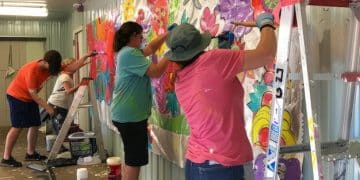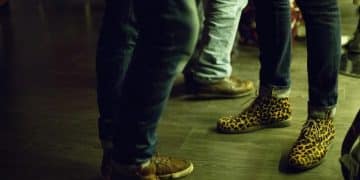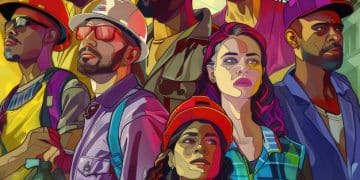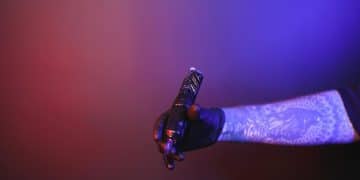Hip Hop & Education: Music Engages Students, Boosts Learning
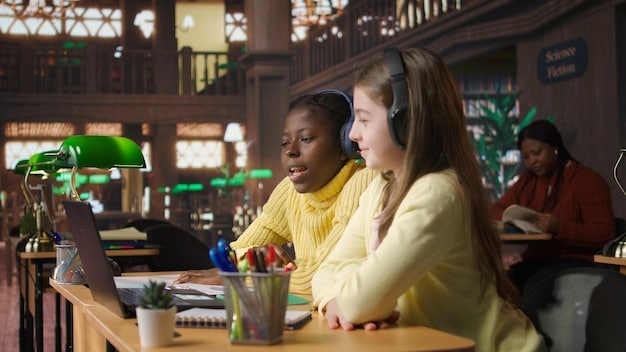
Schools are increasingly integrating hip hop music into curricula to engage students, foster cultural understanding, and improve academic outcomes by leveraging its inherent pedagogical potential and cultural resonance.
The intersection of Hip Hop and Education: How Schools Are Using Music to Engage Students and Improve Learning represents a dynamic and evolving pedagogical approach. Once viewed merely as entertainment, hip hop culture is now recognized for its profound potential to foster engagement, cultural understanding, and critical thinking within diverse educational settings.
The Transformative Power of Hip Hop in the Classroom
Hip hop, born from the streets of the Bronx, has evolved into a global cultural phenomenon, encompassing music, dance, art, and fashion. Its narrative power, rhythmic complexity, and lyrical dexterity offer a unique lens through which to explore history, literature, social justice, and even mathematics. Recognizing this profound influence, educators are increasingly integrating hip hop into their curricula, moving beyond traditional teaching methods to create more relevant and engaging learning experiences for students, particularly those from marginalized communities who often see their lived experiences reflected in hip hop’s authentic narratives.
The conventional classroom, with its rigid structure and often Eurocentric curriculum, can struggle to connect with students from diverse backgrounds. Hip hop offers an authentic bridge, allowing educators to tap into students’ existing cultural knowledge and passions. This approach not only makes learning more relatable but also empowers students, validating their identities and fostering a sense of belonging within the academic environment. It encourages a deeper, more personal connection to subject matter, leading to enhanced comprehension and retention. This transformative power extends beyond mere engagement, impacting critical thinking skills and self-expression, as students learn to deconstruct complex lyrical structures and understand the cultural context informing the music.
From Rhymes to Reason: Engaging Diverse Learners
One of hip hop’s most potent attributes in education is its ability to engage diverse learners. Traditional teaching methods may alienate students who learn best through auditory, kinesthetic, or social means. Hip hop, with its emphasis on rhythm, storytelling, and collaborative creation, naturally caters to these varied learning styles. It provides a platform for expression and critical thought, allowing students to explore complex themes in a format that resonates with them. This inclusive pedagogical strategy actively seeks to meet students where they are culturally, and then build outwards from that foundation, making abstract concepts concrete and relatable.
- Cultural Relevance: Hip hop acknowledges and celebrates the diverse backgrounds of students, forging stronger connections to academic content.
- Enhanced Engagement: The inherent appeal of music captivates student attention, making lessons more dynamic and memorable.
- Creative Expression: Students can craft their own rhymes, beats, and visual art, fostering self-expression and innovation.
Furthermore, hip hop often tackles challenging social issues, providing a safe space for dialogue and critical examination. Students can analyze lyrics that address inequality, poverty, and resilience, promoting empathy and a nuanced understanding of societal complexities. This not only enhances their social-emotional learning but also builds a foundation for active and informed citizenship.
Ultimately, by embracing hip hop, schools are not just updating their playlists; they are revolutionizing their approach to education, creating environments where every student feels seen, heard, and empowered to excel. This shift is critical for preparing students to navigate an increasingly complex and interconnected world, equipping them with both academic knowledge and cultural competence.
Literacy and Language Arts Through Lyrical Analysis
The intricate wordplay, metaphors, and storytelling embedded within hip hop lyrics provide a rich tapestry for language arts instruction. Educators are leveraging this artistic form to enhance literacy skills, from vocabulary acquisition to rhetorical analysis. Students delve into the nuances of lyrical construction, examining how artists use language to convey meaning, emotion, and social commentary. This hands-on approach makes literary analysis feel less abstract and more immediate, bridging the gap between street poetry and academic rigor.
Analyzing hip hop lyrics can be as rigorous as dissecting Shakespearean sonnets or classic American literature. Students explore themes, identify literary devices like alliteration, assonance, and simile, and debate the artist’s intent. This process sharpens their critical reading and thinking abilities, encouraging them to look beyond the surface level of text. Moreover, writing their own rhymes or poetic verses helps them internalize these literary concepts, improving their own writing proficiency in a way that is both meaningful and culturally relevant to their lives.
Deconstructing Rap Verses for Deeper Understanding
Teaching poetry, prose, and rhetoric can sometimes be a struggle in traditional settings. However, when educators introduce rap verses, students often become instantly engaged. The rhythmic cadence and often complex narrative structures found in hip hop lyrics provide an accessible entry point for understanding poetic elements. Students learn to identify rhyme schemes, analyze figurative language, and grasp thematic messages, connecting the art of verse to their own lived experiences. This makes the learning process not only enjoyable but also deeply personal and relevant.
- Vocabulary Expansion: Exposure to diverse linguistic registers and sophisticated terms in lyrics.
- Rhetorical Analysis: Understanding persuasion, argumentation, and emotional appeal in rap verses.
- Narrative Structure: Analyzing how stories are told and developed within complete songs.
Furthermore, workshops on songwriting and spoken word offer students practical applications for their growing literacy skills. They learn how to craft narratives, articulate complex ideas, and express personal experiences through the powerful medium of hip hop. This creative outlet boosts self-confidence and provides an alternative pathway for academic success, showcasing that literacy extends far beyond the confines of textbooks.
By engaging with hip hop, students develop an appreciation for the power of language as both an artistic tool and a vehicle for social change, preparing them to be more discerning consumers and producers of written and spoken word.
Mathematics and Science: The Unexpected Groove
While the connection between hip hop and language arts might seem intuitive, its application in STEM fields is equally compelling. From beat production to sound engineering, hip hop is inherently mathematical and scientific. Educators are finding innovative ways to use these connections to make abstract scientific and mathematical concepts more tangible and exciting for students, transforming the perception of these subjects from daunting to dynamic. This unexpected integration highlights the interdisciplinary nature of real-world knowledge.
The creation of beats involves understanding rhythm, tempo, and time signatures—all rooted in mathematical principles. Sampling and manipulating sound waves require an understanding of physics. Even the economics of the music industry can be explored through a mathematical lens. By breaking down the elements of hip hop into their foundational components, teachers can illuminate complex ideas in a way that resonates with students’ everyday experiences, bridging the gap between theoretical knowledge and practical application. This allows students to see math and science not as isolated subjects, but as integral tools for creative expression and problem-solving.
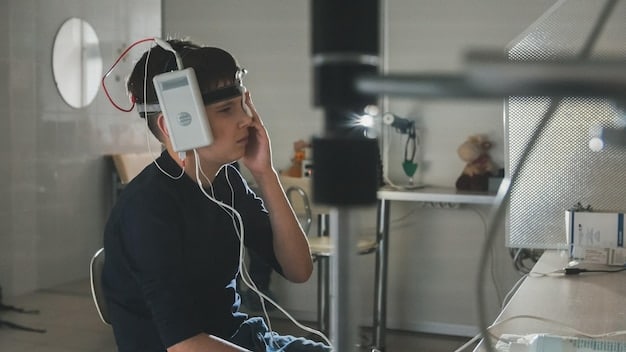
Beats, Rhythm, and Data: STEM in Action
Consider the science behind sound: how vibrations create pitches, how waveforms are manipulated in a digital audio workstation (DAW), or the physics of acoustics in a recording studio. These are fundamental scientific principles that can be illustrated through the lens of hip hop production. Similarly, sampling involves understanding fractions, ratios, and percentages, offering practical applications for mathematical concepts. When students learn to break down a song to its core components, they engage in a form of data analysis, identifying patterns and structures.
Moreover, the rise of data analytics in the music industry, from tracking streaming numbers to understanding audience demographics, provides a real-world context for statistical reasoning. Students can analyze charts, interpret trends, and even predict future successes based on data derived from their favorite artists. This provides a contemporary, high-interest avenue for exploring mathematical concepts that might otherwise seem abstract or irrelevant. Projects might involve calculating royalties, analyzing song tempos in beats per minute (BPM), or decoding complex rhythmic patterns found in different subgenres and styles of rap music.
By exploring the scientific and mathematical underpinnings of hip hop, students not only gain a deeper understanding of these subjects but also develop problem-solving skills and an appreciation for the technical artistry involved in music creation.
Social Studies and History: Rhymes as Records
Hip hop has always been a voice for the voiceless, a chronicle of urban life, and a potent platform for social commentary. Its origins are deeply intertwined with the social, economic, and political landscapes of the late 20th century, making it an invaluable resource for teaching history and social studies. Through the study of hip hop, students can gain a nuanced understanding of historical events, social movements, and cultural shifts from a perspective often marginalized in traditional textbooks.
From the civil rights movement’s echoes in early rap to contemporary critiques of racial injustice and economic disparity, hip hop lyrics offer primary source material that is both authentic and engaging. Students can trace historical narratives, analyze different viewpoints, and understand the evolution of social consciousness through the lens of music. This approach imbues historical lessons with relevance, helping students connect past events to present-day realities and fostering a more empathetic understanding of diverse human experiences.
Cultural Narratives and Historical Contexts
Examining the lyrical content of hip hop allows students to explore historical events and social issues in a context that resonates with their lived experiences. Songs addressing police brutality, economic inequality, and community resilience provide a powerful counter-narrative to mainstream historical accounts. Students can analyze how artists respond to their environment, document their times, and articulate the aspirations and struggles of their communities. This fosters critical thinking and encourages students to question dominant narratives while valuing diverse perspectives.
- Social Commentary: Understanding how artists use their platforms to discuss political and social issues.
- Historical Context: Placing songs within their historical moments to grasp their full significance.
- Cultural Movements: Analyzing hip hop’s role in broader cultural and advocacy movements.
Furthermore, the evolution of hip hop itself mirrors significant changes in society, from technological advancements to shifts in media consumption. Tracing its growth from localized block parties to a global industry provides insights into globalization, entrepreneurship, and the impact of technology on culture. This makes history come alive, demonstrating how cultural phenomena are both products of their time and powerful agents of change, shaping public discourse and influencing social progress over generations.
By using hip hop as a historical lens, educators are not just teaching facts; they are cultivating empathy, critical thinking, and a deeper appreciation for the interplay between art, society, and history.
Creative Arts and Performance: Beyond the Mic
Hip hop is a multidisciplinary art form that extends far beyond just rapping. It encompasses DJing, breakdancing, graffiti art, and beatboxing—elements that provide vast opportunities for creative expression and performance within educational settings. Integrating these diverse artistic components allows schools to foster creativity, build confidence, and develop physical and artistic skills in ways that traditional curricula may not always address. It creates a space for students to explore talents that might not be recognized in conventional academic subjects.
Workshops on beat-making can introduce students to digital music production, combining technology with creative sounds. Breakdance classes promote physical fitness, coordination, and teamwork. Graffiti art lessons, conducted respectfully and often through digital mediums or controlled canvases, can teach color theory, design principles, and historical context. Each discipline offers a unique pathway for artistic development, allowing students to discover and cultivate their talents while engaging with a vibrant cultural heritage.

From Graffiti to Digital Art: Visualizing Hip Hop Culture
The visual arts aspect of hip hop, particularly graffiti, offers a powerful medium for artistic exploration. Beyond its controversial reputation, graffiti is a complex art form rich in typography, color theory, and historical evolution. Educators can lead projects that explore digital graffiti, mural design (with school permission), or creating tag-inspired typography, teaching design principles and artistic expression in a culturally relevant way. This enables students to understand art as a form of communication and a tool for community building.
Performance aspects, such as spoken word poetry and freestyle rapping, build confidence and public speaking skills. Students learn to articulate their thoughts under pressure, adapt to changing circumstances, and connect with an audience. These skills are invaluable not only in artistic pursuits but also in academic presentations, job interviews, and everyday communication, preparing students for success in various aspects of life. Moreover, collaborative performance projects enhance teamwork and mutual respect among peers.
By embracing the multifaceted creative arts of hip hop, schools are nurturing a new generation of artists, innovators, and confident communicators, while simultaneously celebrating the cultural richness that hip hop embodies in its truest form.
Challenges and Best Practices for Implementation
While the benefits of integrating hip hop into education are clear, implementation is not without its challenges. Stereotypes, misconceptions, and resistance from traditionalists can pose significant hurdles. Schools must navigate these obstacles carefully, ensuring that hip hop is integrated thoughtfully and respectfully, with clear pedagogical goals. Addressing concerns from parents, administrators, and the community requires transparent communication and a demonstration of the academic value this approach brings to students.
One primary challenge is ensuring that educators are adequately trained and comfortable with hip hop culture. Professional development programs are essential to equip teachers with the knowledge and skills needed to effectively incorporate hip hop into their lessons, moving beyond superficial appreciation to genuine pedagogical integration. Building a curriculum that is both culturally relevant and academically rigorous requires expertise and a commitment to ongoing learning, ensuring that the content is age-appropriate and aligns with educational standards.
Implementing Hip Hop: Overcoming Hurdles, Maximizing Impact
To overcome these challenges, schools are adopting several best practices. Establishing clear learning objectives is paramount, ensuring that hip hop is used as a tool to achieve specific academic and social-emotional goals, rather than an end in itself. Collaboration with local artists, community organizations, and hip hop scholars can enrich the curriculum and provide authentic learning experiences. These partnerships bring real-world expertise into the classroom, deepening students’ understanding and appreciation for the art form, whether it’s through guest lectures, workshops, or mentorship programs.
- Teacher Training: Providing educators with resources and professional development to confidently teach hip hop.
- Curriculum Alignment: Ensuring hip hop integration supports academic standards and learning objectives.
- Community Engagement: Collaborating with artists and organizations to enrich student experiences.
Furthermore, fostering an open dialogue with parents and the wider community is crucial to building trust and addressing any concerns about content or perceived themes. Showcasing student work, hosting performances, and demonstrating academic improvements can help illustrate the positive impact of hip hop education. Ultimately, successful implementation relies on a commitment to innovation, cultural responsiveness, and a belief in the power of relevant education to transform lives, creating an environment where hip hop serves as a catalyst for positive change and academic achievement.
By embracing these best practices, schools can harness the full potential of hip hop to create dynamic, inclusive, and effective learning environments that prepare students for success in a rapidly changing world, proving that meaningful education isn’t bound by traditional methods.
| Key Aspect | Brief Description |
|---|---|
| 🎤 Engagement | Hip hop captures student interest, making learning more dynamic and culturally relevant. |
| 📚 Literacy Boost | Lyrical analysis enhances vocabulary, critical reading, and writing skills. |
| 🧠 STEM Connections | Beat production and sound engineering illustrate mathematical and scientific principles. |
| 🎨 Creative Expression | DJing, breakdancing, and visual arts offer avenues for artistic development and confidence. |
Frequently Asked Questions About Hip Hop in Education
▼
Hip hop is effective because it resonates culturally with many students, particularly those from diverse backgrounds. Its authentic narratives, relatable themes, and dynamic rhythm capture attention, making learning feel more relevant and personal. This engagement extends beyond passive listening, fostering active participation and a deeper connection to academic content.
▼
Lyrical analysis of hip hop songs can significantly enhance literacy. Students analyze complex wordplay, metaphors, and storytelling, improving vocabulary, reading comprehension, and critical thinking. Writing their own rhymes or spoken word pieces also directly develops writing proficiency and creative expression, bridging the gap between artistic and academic writing.
▼
Absolutely. Hip hop production, from beat-making to sound engineering, is inherently linked to STEM. Students can explore rhythm, tempo, and frequency (math and physics), or analyze data related to music industry trends (data science). This practical application makes abstract scientific and mathematical concepts more tangible and exciting, connecting them to real-world creative processes.
▼
Challenges include overcoming stereotypes about hip hop, ensuring educator training and comfort with the culture, and aligning content with academic standards. Resistance from traditionalists or community concerns also require careful communication and demonstrating the rigorous academic value of such programs. Building trust and showcasing positive student outcomes are key to successful implementation.
▼
Yes, hip hop encompasses various art forms suitable for schools. Beyond rapping and lyrical analysis, schools can integrate DJing (for music theory), breakdancing (for physical activity and coordination), and graffiti art (for visual design principles, often through digital means or murals). These multidisciplinary approaches foster creativity, teamwork, and self-expression.
Conclusion
The journey of hip hop from marginalized street culture to a legitimate pedagogical tool underscores its immense cultural and educational value. As schools increasingly embrace integrated, culturally responsive teaching methods, hip hop emerges not merely as a trend, but as a powerfully effective strategy to engage students, improve academic outcomes across diverse subjects, and foster a deeper, more empathetic understanding of the world. By recognizing and leveraging the inherent strengths of this vibrant art form, educators are redefining the boundaries of learning, creating dynamic environments where every student has the opportunity to thrive and connect with their educational journey in a meaningful way.
